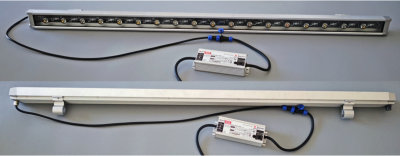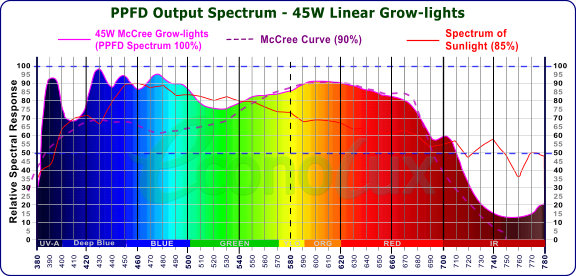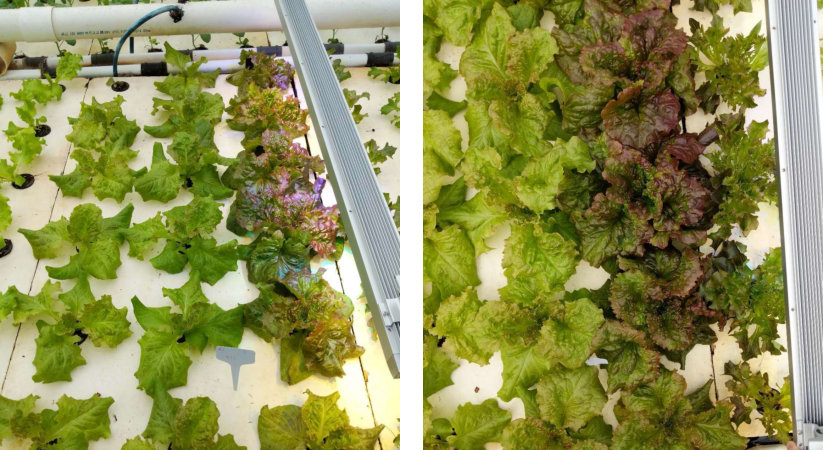Case Study - EconoLux 45W Linear LED Cloning/Greens Grow Lights
Hong Kong Aquaponics Greenhouse Grow Test - Preliminary Results
These are the preliminary test results from the first grow cycle using EconoLux's
45W linear LED grow-light. Results showed that exposure to the McCree curve light (with extra UV and blue), increased the size
of the red lettuce under the lights by about 3 times!
 |
LIGHT: We have provided a Hong Kong Aquaponics Greenhouse with a sample of EconoLux's 45W
Linear LED grow light. These are the preliminary test results from the first growth cycle.
|
SPECTRUM:
The 45W LED grow-light light has a spectrum optimized for cloning or growing greens. The image on the right shows the PPFD
spectrum, with the McCree curve overlaid (at 90%), and the spectrum of sunlight overlaid (at 85%).
Note the close match of the light to the McCree curve.
The additional UV and blue light, which is more than the McCree curve, but
which is preferred by seedlings, clones,
Micro-greens, herbs, basil, lettuces, and other leafy green plants. |
 |
|
TEST CROP:
Red Leaf Lettuce (Lactuca sativa) grown in a greenhouse, with natural light supplemented by the LED light, under
the following conditions:
| |
► Grow cycle 30 days, first 23 days with 12/hrs per day of light
► Last 7 days with 24/hrs per day of light
► Ideal grow temperature for this crop is 17~18C
► Average daytime temperature was between 8~10C - average
► Night-time temperature was between 5~8C (winter in HK)
► Water temperature in the growing pan was -2C below the ambient air temperature
|
The photo (on left below) shows the test growing pontoon in the Aquaponics pan. The 45W linear LED light is visible on the right.
Note that the lettuces below the light are larger and healthier.
The photo on the right below shows the crop towards the end of the 30 day growing cycle. Note
that the lettuces have better coloration, than the
neighbouring rows which have less exposure to the LED light. |
 |
|
The photos below show representative samples of the lettuce plants after harvesting. The
plants on the left of the photos had no exposure to the LED light. The plants in the center of the image had some exposure to the
LED light, while the plants on the right of the photos were grown directly under the LED light.
|

|
RESULTS:
The results were as follows, with representative plants 1 on the left (no exposure to the LED light),
representative plants 2 in the middle (some
exposure to the light), and representative plants 3 on the right (plants grown directly below the LED light):
|
| |
Average Weight with roots:
► Plant 1 - 76g
► Plant 2 - 90g
► Plant 3 - 159g
|
Average Weight without roots:
► Plant 1 - 24g
► Plant 2 - 38g
► Plant 3 - 89
|
TASTE AND TEXTURE DIFFERENCES:
Compared to the other lettuce plants, the plants grown
directly under the LED lights have a more intense and
sweeter taste; the texture difference is huge, as they are a
lot cruncher.
NEXT TEST:
The grower will switch to a 16 hour/day light schedule for the first 20 days, followed by a 24
hour/day light schedule for day 21 to day 30
GROWERS COMMENTS:
Under far less than ideal conditions, the lettuce grown directly under the LED lights is 3.7 times heaver
than the ones grown without the lights. There are also taste and texture improvements.
If we can raise the ambient air temperature by 10C constantly, and supply more air to the root zone
(nano bubble), than we expect we can produce 200~250g lettuces in 30 days (currently we can grow
the lettuce to 500g in 50 days).
NOTE: While the test grow used red leaf lettuce, the results
should be similar for other leafy green plants, and also for
cloning and germinating cannabis plants.
|



